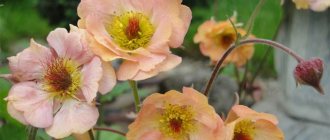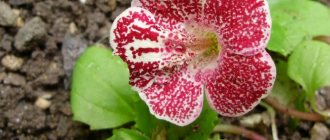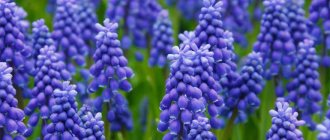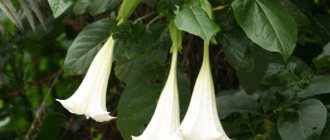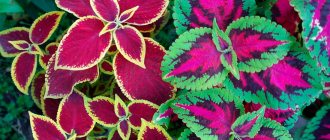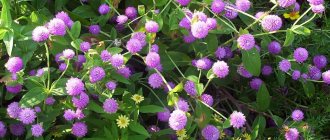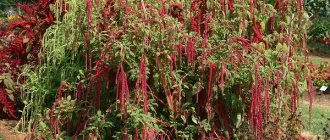If you're looking for an ornamental plant that can be grown near bodies of water or in damp areas, loosestrife is worth considering. Although the species is associated mainly with wet meadows, lake shores or forest clearings, where it is very common, nothing prevents these beautiful and majestic flowers from becoming a wonderful decoration in the garden. Find out how to properly grow loosestrife - planting and care in open ground, photos of varieties, how to propagate the plant.
Description of the plant
The most popular species grown in our country is loosestrife (Lythrum salicaria L.). This is a perennial plant from the Derbennikov family, one of the few species of the genus Lythrum, found in the flora of our country everywhere except the Arctic. Also distributed throughout Europe and Asia.
The perennial is characterized by an impressive size - up to 150 cm, sometimes 200 cm in height in older specimens growing in exceptionally favorable conditions. In spring, from a strong underground part, the plant develops a loose rosette of heart-shaped, lanceolate, hairy leaves. At the beginning of summer, long, hard, slightly pubescent and leafy flower stalks grow from the rosette, on which small, brightly colored pink-purple flowers are collected in long, dense inflorescences. The size of the inflorescences can reach 30 cm.
Plant morphology:
- The stem is one, with several short branches in the upper part, erect, pubescent, angular - tetrahedral, 50-130 cm high. Each shoot has a large oblong inflorescence.
- Leaves are opposite or whorled (3 leaves per whorl). The lower leaves are heart-shaped, pubescent on prominent veins, the upper ones are narrowly lanceolate, twisted, 8-10 cm long.
- The flowers are small, carmine pink in color, collected in dense spike-shaped inflorescences, up to 30 cm long. The flower consists of a calyx with sepals (6 small sepals), 6 petals, a pistil and 12 stamens (6 short, 6 long). The flowers have a three-sided polygonal shape. Flowers gradually develop from bottom to top.
- The fruits are oblong capsules, covered with a dry bowl. The box has a compartment that bursts when ripe; the seeds are small.
- The root is a strong, woody root system.
Perennial moisture-loving, frost-resistant. In its natural habitat it grows in damp meadows, ditches, coastal thickets, on the banks of swamps and reservoirs. It is grown in water gardens as a very decorative element of the banks of a reservoir and in flower beds.
Photo. Loosestrife in the natural environment
This one is interesting! The plant is also called Plakun-grass, due to the fact that in conditions of excess moisture droplets appear on its leaves, the plant seems to be crying.
Merlin usually blooms in late June or July for 4-6 weeks. The plant has male and female flowers on the same stem and is pollinated by bees. Seeds arise only as a result of cross-pollination. The plant is a honey plant; the flowers are visited by butterflies and bees collecting nectar.
This is interesting! At the turn of the 18th and 19th centuries, many ships sailed between Europe and North America with goods necessary for Europeans to colonize the New World, such as iron, fabrics, furniture, and farm animals. To increase stability, ships carried ballast in their holds, usually stones, gravel, and sand from European coasts. Along with these materials, loosestrife came to America and is now considered one of the most harmful weeds in the United States and Canada.
The species in nature inhabits wetlands, especially on the edges of rivers and lakes. Because of this, the plant is so unloved in North America, where it disrupts the natural balance of water bodies and limits their recreational potential. They call him A Beautiful Killer. In the United States, losses caused by the invasion of loosestrife into agricultural and livestock areas are estimated at millions of dollars! The plant appears there more and more often in dry areas, suffocating other types of flora with its strong roots.
There are many sites on the English-language Internet dedicated to how to destroy loosestrife, a killer of other plants. These pages contain many photographs of the various insects that eat this plant. But we have no problems - our wonderful climate itself solves all problems thanks to winter. But it doesn’t snow everywhere; where it’s very warm, the merlin grows uncontrollably.
Varieties
Among local flower growers, the twig-like and willow-like loosestrife are known. There are not particularly noticeable differences between these varieties.
Willow loosestrife
This species is found in Asia and European countries. The height of the perennial can be from 80 to 140 cm. An erect stem with green leaves and spike-shaped inflorescences in the form of purple stars. With the onset of autumn, the foliage takes on a reddish tint. Small grains ripen in an oblong seed capsule. Famous varieties of willow-like loosestrife are: “Pink Pearl”, “Robert”, “Lady Sackville”, “Blanche”.
Derbennik twig-shaped
The plant is light-loving and profusely flowering, and can tolerate short-term drought. The flowering period is July-August. The height of the bush is 60-120 cm. It is found in nature in European and Asian countries. The color is brighter than that of the willow, the stem may be slightly branched, and the inflorescences are loosely spaced. Popular varieties of twig loosestrife are: “Helene”, “The Rocket”, “Modern Gleam”, “Rose Queen”, “Dropmore Purple”, “Modern Pink”.
Varieties - photos and descriptions
Merlin is usually grown as a natural species, but sometimes in garden nurseries you can find decorative varieties of loosestrife:
- “Blush” Blush is a variety with pale pink flowers.
- "Robin" Robin is a variety with bright pink flowers.
- "Robert" Robert - reaches a height of 90 cm, with very dense, brightly colored, pink inflorescences.
- "Little Robert" Little Robert is a variety with flowers similar to the Robert variety, but much smaller in height, reaching 40-50 cm.
Requirements for soil and planting site
The loosestrife flower is not a capricious species; it tolerates light sandy soils and heavy clay soils. For good growth and flowering, it needs a lot of moisture, so it should be planted near ponds, rainwater drains, on the edge of a regularly watered lawn. Feeling the water, the plant will gladly “descend” lower to the water and will grow right in it. Flowers grow well near a pond when their roots are completely submerged in water at a depth of 10 cm.
In a good position, the plant grows quickly, eventually forming a large, beautiful bush. It has a strong, woody, deeply penetrating root system, so although the flower prefers moisture, it copes well with temporary droughts. In drier areas it grows smaller and blooms less.
The perennial is not bothered by either the acidic or alkaline reaction of the substrate; it loves the sun and grows well in moderate shade. However, loosestrife is light-loving and does not tolerate too much shade.
There is no need to worry about adding compost to the soil; loosestrife will grow luxuriantly even in poor soil. Grows well in wetlands and can be periodically flooded. Does not like light, rocky, sandy soils.
Soil pH does not have a significant effect on the plant
Landing
Loosestrife can be planted as ready-made seedlings or from seeds. The first option is more popular, as it saves a lot of time and makes it easier to choose the right option.
Planting loosestrife in open ground:
- Before planting, remove the seedlings from the pot and immerse them in a bucket of water for several hours.
- We dig a hole 20-30 cm wide and 30-40 cm deep.
- We place the root ball soaked in water in the hole so that it is completely covered with soil.
- After burying, we shorten all shoots with pruning shears by 1/3 of the length.
- Water the plant well.
Often, merlin seeds are sown immediately in open ground. As an alternative, you can sow the seeds in the substrate, and after germination and reaching a few centimeters of growth, transplant them into open ground, maintaining a distance of 50-70 cm between individual plants (they grow wider). Low varieties are planted more densely.
Contraindications
Plakun has a unique chemical composition. Some components may be harmful when using merlin-based products. Experts indicate the following contraindications to taking infusions and decoctions of the verbulite:
- pregnancy;
- lactation;
- children's age (up to 12 years);
- individual intolerance.
Before using God's herb, you need to make sure there are no hypersensitivity reactions. The broth is dripped onto the wrist area and waited for 30 minutes. The traditional medicine is considered safe in the absence of redness.
Important! Caution should be exercised when using the medicines for people with high blood pressure. Plakun promotes vasoconstriction.
The use of loosestrife is strictly contraindicated in the following cases:
- atherosclerosis;
- increased blood clotting;
- intestinal inflammation;
- tendency to thrombosis;
- pressure surges;
- frequent constipation.
Growing and care
Merlin, planted in the right place, is durable, does not cause any problems in cultivation, and does not require special care. It is also relatively disease and pest resistant and requires no pruning. It is recommended to remove faded inflorescences.
Breaking off faded inflorescences
After flowering, the inflorescences should be removed to avoid spontaneous spread of seeds. In addition, cutting off the inflorescences, done early enough (before the flowers are completely dry), can stimulate the plant to bloom a second time in the fall. It will be less abundant, but quite decorative.
Watering, fertilizing
Loosestrife loves water, even wetlands, so it is ideal to plant it in areas that naturally retain moisture. Otherwise, it will require frequent watering. Nothing will happen to the plants if they have a drier substrate for a few days.
Long-term lack of water negatively affects flowering. Much attention should be paid to watering young plants that are susceptible to drying out.
The merlin usually does not need fertilizing with mineral fertilizers. It is enough to add compost to the soil before planting, although this is often not required. Fertilizer is needed only on poor soils, applied 1-2 times a year. Organic fertilizer is optimal. When choosing a mineral fertilizer, pay attention to the composition. Merlin likes a lot of potassium and phosphorus, less nitrogen.
Mulching is worth using, especially when growing on a less moist substrate. A thick layer of mulch reduces the risk of weed infestation and reduces water evaporation from the soil.
Diseases, pests, problems during cultivation
As befits an invasive species, loosestrife requires no protection from gardeners. It is completely frost-resistant and does not need to be covered for the winter. However, for aesthetic reasons, you can cut off the shoots right at the ground before winter.
The loosestrife has virtually no diseases or pests - it attracts many bees and butterflies, which can be considered a great advantage, especially in gardens with shrubs and fruit trees that need natural pollinators.
Preparing for winter
Merlin is completely frost-resistant and belongs to hemicryptophytes - plants that overwinter underground. Its entire above-ground part dies off in winter, and in spring it grows again from buds on the rhizomes.
The perennial is adapted to the weather conditions prevailing in our country. You can plant and care for loosestrife in open ground in the Moscow region, Siberia, and the Urals. It tolerates low temperatures well and does not require winter shelter.
Types of healing compounds
Various medicines are prepared from loosestrife. Each has a unique property and is used to treat certain diseases. Infusions, decoctions, and tinctures are prepared from this herb.
Infusion
This remedy has a number of positive properties. The infusion is used for stomach pain and migraines. It is used to make lotions for wounds and sore joints and for severe bruises. The infusion has an anti-inflammatory effect and improves the functioning of the immune system. This infusion is also effective for treating hemorrhoids. It will also be useful for acne, thanks to its ability to relieve inflammation.
For preparation you will need 20 g of leaves and 1 glass of water. Grind the raw materials thoroughly, then pour boiling water over the plant, then leave to steep for 40–50 minutes. Cool the finished medicine, strain, and take 50 ml 4 times a day, regardless of meals.
Tincture
The tincture is used to treat many diseases. It effectively helps with migraines and diarrhea, strengthens the immune system and has antibacterial properties.
To prepare it you will need chopped leaves and stems. Mix them with vodka or alcohol in a ratio of 1:10, then close it tightly and place in a dark and cool place for 2 weeks. Shake the medicine periodically. After 14 days, strain the medicine. Store the finished tincture in the refrigerator in a glass container. Drink 20 drops diluted in water three times a day. Take the medicine 20–30 minutes before meals.
Decoction
The decoction is famous for its diuretic. It is also used to treat wounds and ulcers against infections. The prepared decoction is often added to a hot bath. This allows you to get rid of tension and relieve stress. The decoction has a sedative effect and can help with various sexually transmitted diseases. Women have been taking it for menstrual irregularities since ancient times, but first consult a doctor.
Decoctions from the roots of the plant are used to treat seizures and diseases of the upper respiratory tract. It has expectorant and anti-inflammatory properties. A decoction of loosestrife is used to rinse the mouth for ulcers and gumboils.
To prepare a medicine from the roots you will need 1 teaspoon of crushed raw materials and 200 ml of water. Pour boiling water over the roots, then bring to a boil over low heat and cook for another 15–20 minutes. Leave the finished broth for 60 minutes, then strain. This decoction is mainly used externally to treat wounds, bruises, etc.
To prepare a decoction of leaves and stems you will need 1 tbsp. a spoonful of crushed raw materials and 200 ml of boiled water. Fill the plant with water, then place in a water bath for at least 15 minutes. Infuse the decoction for 1 hour. Only after this can you strain it and drink 50 ml three times a day.
Tea
Tea has a general strengthening effect. It increases the body's protective functions, helps resist viruses and bacteria, and has a diuretic. It can even stop internal bleeding, but in case of such a problem it is better to consult a doctor immediately. Tea can also help with diarrhea and stomach pain.
The flowers of the plant are used to make tea. You will need a handful of raw materials and 1 liter of boiling water. Pour water over the flowers, then cover with a lid and leave for 20–30 minutes. Drink 3-4 small cups per day. You can add lemon, honey or other healthy herbs to tea, this drink will be even more effective. You can also add a small amount of the herb to regular tea.
Reproduction
Reproduction of loosestrife is very simple; it can be propagated by seeds, dividing bushes, or cuttings.
Seeds
As mentioned above, the loosestrife reproduces quite intensively on its own. The plant produces seeds willingly and in large quantities if it has a chance of cross-pollination (growing next to another specimen of the same species). It produces large amounts of nectar, making it an attractive plant for butterflies. Thanks to this, almost every flower sets seeds.
One mature plant produces 2 million seeds per year, which are easily dispersed by wind and overwinter in the soil without problems.
By cutting off dried inflorescences, the process of self-sowing can be controlled by sowing later collected and dried seeds in selected areas. Merlin seeds can be sown in the ground immediately after harvesting. This is how the natural form of the plant is propagated - the natural species.
Artificial ornamental varieties are sometimes sterile (which will please a significant part of gardeners), and in viable seeds they do not transfer the full genetic material.
By division
Young plants can be obtained by dividing an adult bush, although due to the strong and branched root system, this procedure requires the use of considerable force. It is recommended to use a shovel to cut through the strong and difficult to remove root system.
Cuttings
You can effectively propagate loosestrife by shoot cuttings. To do this, in April we cut off a few centimeters of the branches of the stem and place them cut side down in damp compost. When kept warm and constantly moist, the cuttings will develop roots within a few weeks and can be planted in the area.
Application
In the garden, loosestrife can perform a number of decorative functions:
- Like a tall summer flower, it makes a perfect background for a flower bed, right next to the fence.
- Low varieties can be planted in the foreground of the flower bed.
- Planted in groups of 6-10 plants, it looks good as an island in a flower bed, lawn, or a colorful addition to tall grasses.
- Beautifully surrounded by lake and garden ponds.
Loosestrife is a beautiful, decorative and attractive garden plant, suitable for planting on the banks of ponds, where it looks good in the company of other moisture-loving species:
- meadowsweet,
- common loosestrife,
- veronica longifolia,
- Siberian iris,
- Iris false calamus,
- marsh marigold,
- jagged buzulnik,
- Tradescantia virginiana,
- horsetail.
Photo. Merlin in the garden - by the pond
In areas with a sufficiently moist substrate, it can be planted in perennial flower beds or combined with other ornamental plants:
- echinacea,
- common yarrow,
- helenium.
This species will cope with drier soil, but in such conditions it will bloom lower and less. When planting it in the garden, you should remember that the plant is quite expansive and, if somewhere it is too good for it, it grows strongly, suppressing other species.
Merlin is also suitable as a cut flower for bouquets; it stays fresh in a vase for a long time.
In general, the plant is recommended primarily for landscapes in a rustic, natural style, where a little wild spontaneity is welcome.
Before becoming an environmentalist's horror in North America, loosestrife was a valuable honey and medicinal plant in Europe for many centuries. Pedanios Dioscorides, a Greek physician who lived in the 1st century AD, described the medicinal properties of loosestrife due to the high tannin content in the root - the ability to stop external and internal bleeding.
To this day, herbalists recommend infusions of it as a gargle for sore throats. Tannins present in plant tissues have a strong astringent and antibacterial effect. Infusions of loosestrife limit heavy menstruation and bring relief from gastrointestinal diseases. You can make your own infusions from dried and cut leaves, stems and flowers.
Merlin in landscape design
Thanks to its decorative qualities and long flowering, loosestrife always looks impressive in the landscape design of a garden or personal plot.
Gardeners and designers use it to design microborders and create flower beds. This plant also looks good in single plantings, as a bright accent spot.
Plakun is planted on the edge of an artificial reservoir (stream or pond), at the entrance to the garden and at the foot of the rock garden. They are used to camouflage fences, sheds and other unsightly places.
Irises, daylilies, catnip, astilbe and other moisture-loving plants will be good neighbors for flowering grass. Oregano, valerian, cottonweed, thyme and echinacea planted together with loosestrife will attract butterflies and create an exotic corner. Honey-bearing aromatic herbs will be visited by bees in search of pollen and nectar. An apothecary garden can be made up of burnet, elecampane and goldenrod.
When choosing companions for the weeping plant, you must remember that this strong and powerful plant is capable of gradually displacing weaker crops. Therefore, you need to choose equally resistant herbs and shrubs as neighbors.
Summary
Should you be afraid to plant loosestrife? In a neat, well-kept garden it can be controlled in the same way as other easily spread flowers. Those who are afraid of spontaneous propagation of the plant and do not want to fight the seeds should choose improved varieties of loosestrife, which do not have the ability to spread at all. An example of such a variety is Feuerkerze, an extremely ornate variety with double flowers.
Loosestrife is a beautiful perennial that is worth using for special purposes, such as planting in damp or wet areas. In such conditions it grows well, paying us back with abundant flowering.

